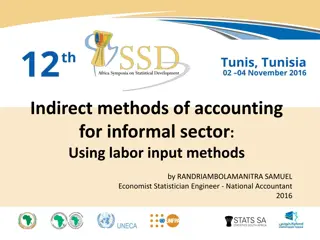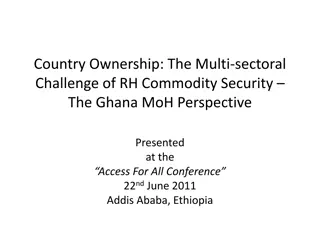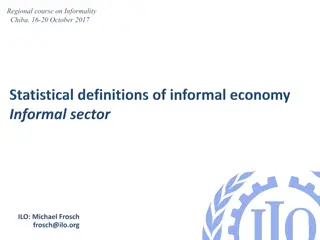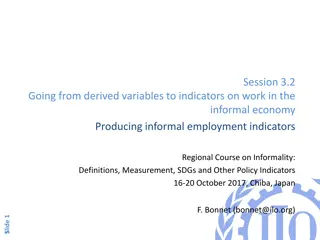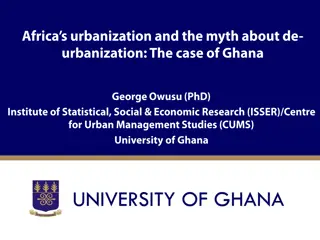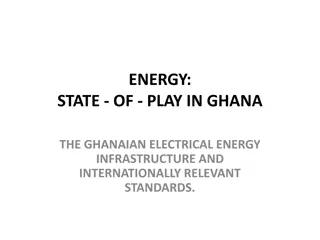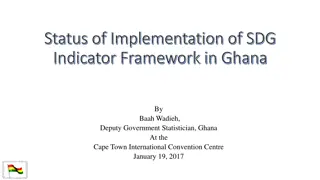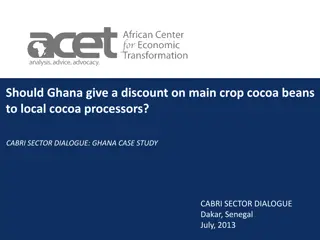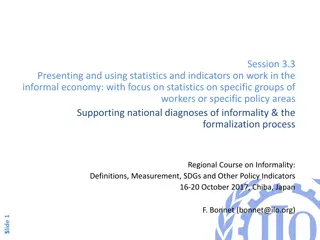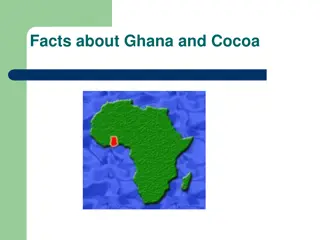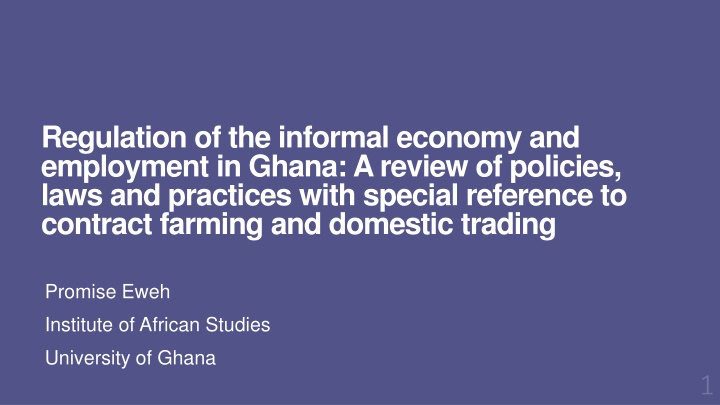
Regulation of the Informal Economy in Ghana: A Policy Review
This review examines the policies, laws, and practices concerning the informal economy in Ghana, with a focus on contract farming and domestic trading. It delves into the regulation and formalization of informal employment, providing insights into the macroeconomic context and key data sources.
Download Presentation

Please find below an Image/Link to download the presentation.
The content on the website is provided AS IS for your information and personal use only. It may not be sold, licensed, or shared on other websites without obtaining consent from the author. If you encounter any issues during the download, it is possible that the publisher has removed the file from their server.
You are allowed to download the files provided on this website for personal or commercial use, subject to the condition that they are used lawfully. All files are the property of their respective owners.
The content on the website is provided AS IS for your information and personal use only. It may not be sold, licensed, or shared on other websites without obtaining consent from the author.
E N D
Presentation Transcript
Regulation of the informal economy and employment in Ghana: A review of policies, laws and practices with special reference to contract farming and domestic trading Promise Eweh Institute of African Studies University of Ghana
Data Sources World Development Indicators (WDI), World Bank Ghana Living Standards Survey (GLSS) Population and Housing Census Reports The scholarly literature on the Ghanaian economy, labour issues, and the informal economy
Outline of Presentation Macroeconomic and labour market context Employment in Agriculture and Domestic Trading Regulation and formalisation of informal employment in Ghana Regulation in agriculture and contract farming Conclusion
Macroeconomic context Annual GDP Growth Annual GDP Growth Average: 6.2 14 14 9.3 9.3 9.1 9.1 8.5 8.5 7.9 7.9 7.3 7.3 6.4 6.4 5.9 5.9 5.6 5.6 5.2 5.2 4.8 4.8 4.5 4.5 4.3 4.3 4 4 4 4 3.8 3.8 3.7 3.7 3.7 3.7 2000 2001 2002 2003 2004 2005 2006 2007 2008 2009 2010 2011 2012 2013 2014 2015 2016 2017 Source: World Development Indicators (WDI), 2018 Source: World Development Indicators (WDI), 2018
Macroeconomic context Ghana signed on to The Highly Indebted Poor Country (HIPC) initiative jointly introduced by the IMF and the WB in the late 1990s. The Multilateral Debt Relief Initiative (MDRI): offered total relief from debts owed to the IMF, the International Development Association (IDA), and the African Development Bank (AfDB) Debt service-to-revenue ratio, reduced from 80% in 2000 to 7.6% in 2003 Increased spending in the social sector: government expenditure on basic education, healthcare, etc. The National Health Insurance Scheme (2003), the Ghana School Feeding Programme (2005) and the Livelihood Empowerment against Poverty (2008)
Macroeconomic context In 2011, GDP growth was estimated at 14% and Ghana was declared the fastest growing economy in Sub-Saharan Africa (WB, 2011) Classification of Ghana as a lower-middle income country in 2010: GDP per capita exceeded $1,300 Significant increases in production and favourable terms of trade for Ghana s primary exports commodities: Cocoa, gold. The discovery of oil in 2007 and its production from 2010 onwards.
Macroeconomic context Growth has also faltered: - A nationwide power-rationing exercise between 2012 and 2015 in response to a shortfall in the supply of electricity. - The Single Spine Salary Policy (SSSP): Doubling of government expenditure on the payment of workers in the public sector - oil trading: June 2014 (US$111.8); By August 2015 (US$50.60) - classification as a lower-middle income has negatively affected concessional borrowing - Ghana s gross debt as a percentage of GDP was estimated at nearly 72% in 2017 compared to 26% in 2006 (The IMF s World Economic Outlook Database).
Changes in the structure of the Ghanaian economy CONTRIBUTION OF AGRICULTURE, INDUSTRY AND SERVICES SECTORS TO GDP CONTRIBUTION OF AGRICULTURE, INDUSTRY AND SERVICES SECTORS TO GDP 28 28 31 31 29 29 30 30 34 34 38 38 50 50 51 51 12 12 18 18 27 27 25 25 17 17 25 25 19 19 28 28 60 60 48 48 45 45 43 43 37 37 36 36 32 32 22 22 1980 1985 1990 1995 2000 2005 2010 2014 Agriculture Industry Services Source: ISSER 2016; 2015 Source: ISSER 2016; 2015 Ewusi Ewusi 2013 2013
Changes in employment EMPLOYMENT BY SECTOR EMPLOYMENT BY SECTOR 30 30 30 30 34 34 35 35 41 41 43 43 44 44 14 14 16 16 16 16 16 16 14 14 14 14 15 15 56 56 54 54 50 50 49 49 41 41 43 43 42 42 1991 1995 2000 2005 2010 2015 2017 Agriculture Industry Services Source: WDI Source: WDI
Labour market context Labour Force Labour Force 10,876,470 10,876,470 8,292,114 8,292,114 5,905,926 5,905,926 5,580,104 5,580,104 4,614,595 4,614,595 1960 1970 1984 2000 2010 Labour Force Source: (GSS 2005; 2013). Source: (GSS 2005; 2013).
Employment Employment Rates, By Sex, 1960 Employment Rates, By Sex, 1960- -2012/13 2012/13 97.5 97.5 96.8 96.8 96.1 96.1 95.2 95.2 95.2 95.2 94.8 94.8 94.6 94.6 94.5 94.5 94.2 94.2 93.8 93.8 93.5 93.5 92.3 92.3 89.9 89.9 89.3 89.3 84 84 80.8 80.8 80.7 80.7 80.6 80.6 1960 1970 1984 1991/92 1998/99 2000 2005/06 2010 2012/13 Male Female
INFORMAL EMPLOYMENT IN GHANA (2000, 2010). 2000 2010 Employment sector Public Private Formal Private Informal Semi Public/Parastatal NGO(Local & International) International Organizations* Other** All Sectors N Both Sexes 6.4 8.5 83.9 0.8 0.4 Male 8.3 10.9 79.1 1.2 0.5 Female 4.5 6.0 88.8 0.4 0.2 Both Sexes 6.2 6.8 86.2 0.1 0.5 Male 8.1 9.7 81.2 0.2 0.7 Female 4.5 4.1 91.0 0.1 0.3 - - - 0.05 0.1 0.03 0.1 100 7,428,374 0.1 100 3,748,887 0.1 100 3,679,487 - 100 10,243,447 - 100 5,005,522 - 100 5,237,925 GSS 2013: 268 GSS 2013: 268
Employment status Employment status of currently employed population 15 years and older by Employment status of currently employed population 15 years and older by sex, type of locality and region sex, type of locality and region 68 68 65 65 60 60 27 27 20 20 14 14 4.8 4.8 12.5 12.5 2.8 2.8 3.7 3.7 9.1 9.1 5.1 5.1 0.5 0.5 0.3 0.3 0.6 0.6 0.6 0.6 0.8 0.8 0.5 0.5 1.2 1.2 1.2 1.2 1.1 1.1 PAID EMPLOYEE OWN ACCOUNT WORKER CONTRIBUTING FAMILY WORKER DOMESTIC EMPLOYEE CASUAL WORKER APPRENTICE OTHER Total Male Female GSS 2016: 34 GSS 2016: 34
DISTRIBUTION OF WORKING POPULATION (15 YEARS AND OLDER) BY INDUSTRY, LOCALITY AND SEX, 2013 (%) Industry Agriculture, Forestry, Fishing Wholesale and Retail trade Sub-Total Manufacturing Accommodation and Food service activities Transportation and Storage Education Male Female All 48.2 10.3 58.5 7.7 0.9 41.4 28.0 69.4 10.3 6.7 44.7 19.5 64.2 9.1 3.9 7.7 4.4 0.3 2.9 3.8 3.6 GSS 2014:26 GSS 2014:26
Major Occupation Of Employed Persons (15 Years And Older) 1960 1960 1970 1970 1984 1984 2000 2000 Employed Population Share Of female 19.7 Employed Population Share Of Femal e 23.5 Employed Population Share Of female 35.7 Employed Population Share Of female 37.0 30.0 23.5 70.5 63.1 49.1 40.9 49.7 Major Occupations Professional & Technical Administrative/Managerial Clerical Sales Services Agriculture, Animal Husb. Production and transport Lab. Total 60,005 13,354 43,348 345,603 55,318 1,563,533 478,220 2,559,383 119,675 11,323 86,366 413,510 90,164 221,704 16,246 127,575 750,179 130,736 541,914 24,569 382,629 3.1 7.4 80.4 29.1 36.9 1,798,256 21.9 613,753 38.7 3,133,047 5.2 15.5 87.8 23.3 42.9 3,288,808 35.4 887,232 45.2 5,422,480 8.8 29.8 89.0 1,270,115 34.7 495,718 47.3 4,072,156 44.8 1,505,013 51.4 8,292,114 GSS GSS 2000:59 2000:59
Share of economically active population in occupations: 2010 Census Women comprise 47% of the economically active population involved in agriculture while the corresponding figure for men is 53%. With respect to services and sales, women comprise 76% while males constitute 24% (GSS, 2013: 139-140).
Domestic trading The Integrated Business Establishment Survey (IBES) - nationwide non-household economic census conducted by the GSS in the last quarter of 2014 - Covered only establishments : formal and informal establishments - All units of production whose physical location are fixed and can be described and traced - All shops/stores/units of production which are visible outside the residential premise/attached to the residential premise, but have access to entry or exit by customers/public - All shops in a complete structure (popularly called store) in the market place
Domestic trading Out of the 3,383,206persons engaged by all establishments , wholesale and retail trade emerged as the most significant provider of jobs, employing a total of 817,848 persons (24% of all workers surveyed). The proportion of women in wholesale and retail trade (25%) exceeded that of men (23%) by only 2 percentage points. In fact, the actual number of men engaged in wholesale and retail trade (479,816) was significantly larger than the figure that was reported for women (338,032). The IBES it left out many workers in the informal economy who could not be identified with establishments . This specifically included the following: all mobile businesses e.g. hawkers traders in open spaces , traders in homes where shops are NOT visible , and all trading units which are mainly, retail shops selling on small tables under sheds. E.g. market sheds, and stalls without permanent occupants (GSS, 2015: 3).
Domestic trading This leads us to conclude that the general idea that women predominate in trading is problematic. In reality, they only predominate in the bloated survival activities of the trading sector while their entry and participation in the smaller but capital required segment is restricted.
Informality in domestic trading and agriculture
Informality in domestic trading and agriculture - Whether there was a contract - Access to subsidized medical care - whether workers are entitled to social security
Occupation and Type of Contract Was there a contract Yes, written Yes, oral/verbal 87 81 84 69 76 33 10 17 27 23 Occupation Armed Forces Occupations Managers Professionals Technicians and associate professionals Clerical support workers Service and sales workers Skilled agricultural, forestry and fishery workers Craft and related trades workers Plant and machine operators, and assemblers Elementary occupations No Total 13 10 7 13 16 40 45 51 49 49 0 9 9 100.0% 100.0% 100.0% 100.0% 100.0% 100.0% 100.0% 100.0% 100.0% 100.0% 18 8 27 45 32 24 28 Based on GLSS 6
Access to subsidized medical care Entitled to subsidized medical care Occupation Armed Forces Occupations Managers Professionals Technicians and associate professionals Clerical support workers Service and sales workers Skilled agricultural, forestry and fishery workers Craft and related trades workers Plant and machine operators, and assemblers Elementary occupations Total 100.0% 100.0% 100.0% 100.0% 100.0% 100.0% 100.0% 100.0% 100.0% 100.0% Yes 78 50 35 48 47 18 8 9 16 16 No 22 50 65 52 53 82 92 91 84 84 Based on GLSS 6
Entitled to social security Entitled to any social security Occupation Armed Forces Occupations Managers Professionals Technicians and associate professionals Clerical support workers Service and sales workers Skilled agricultural, forestry and fishery workers Craft and related trades workers Plant and machine operators, and assemblers Elementary occupations Total 100.0% 100.0% 100.0% 100.0% 100.0% 100.0% 100.0% 100.0% 100.0% 100.0% Yes 45 72 74 55 59 26 9 11 20 19 No 55 28 26 45 41 74 91 89 80 81 Based on GLSS 6
Regulation and formalisation of informal employment in Ghana
Regulation Over the past decade, no single theme has dominated the concept of informality as that of regulation . This is clearly evident in the definitions of informality, the informal economy or informal employment: the informal economy has continued to prove a useful concept to many policymakers, activists, and researchers because the reality it captures the large share of economic units and workers that remain outside the world of regulated economic activities and protected employment relationships is so large and significant. (Chen, 2006: 1)
Regulation While early discussions of economic informality in the 1970s and 1980s were plagued by definitional controversy, the reality is that the major definitional debates were resolved over two decades ago. The prevailing definition accepted across disciplinary and ideological boundaries is that the informal economy refers to income generating activities that operate outside the regulatory framework of the state (Meagher, 2013: 2)
Regulation Regulation also maintains a strong presence in policy circles because it is recognised that enterprises that are informal are more likely to be a source of informal employment to the working population. The ILO, states that: When enterprises are outside the legal and regulatory framework, so too are their workers, who then do not enjoy the protection of the law. (ILO, 2002: 28)
Regulation Kanbur (2009) however maintains that the literature on informality is replete with different definitions of the concept and that this has sometimes resulted in wrong policy choices. He comments that the literature as a whole is a mess of alternative conceptualisations and different measures (2009: 36).
Regulation in agriculture The concept of the informal sector is urban biased: - Informal sector employment: all own-account workers (excluding administrative technicians) and unpaid family workers, and employers and employees working in establishments with fewer than five or ten persons engaged, depending on the available information. Paid domestic workers and agriculture are (ILO 2002: 15) workers, professionals and excluded.
Regulation in agriculture Hussmanns (2004: 3): - The 15th ICLS [International Conference of Labour Statisticians] recognised that, from a conceptual point of view, there was nothing against the inclusion, within the scope of the informal sector, of private unincorporated enterprises engaged in agricultural and related activities, if they met the criteria of the informal sector definition. The recommendation to exclude agricultural and related activities from the scope of informal sector surveys, and to measure them separately, was however made for practical data collection reasons .
Regulation in agriculture In Ghana, poverty, food insecurity and low wages are more likely to be reported for areas where agriculture is the mainstay of the employed population (FAO, 2012: 7, 16-18). The recognition and critical analyses of informality in agriculture is thus crucial for achieving decent work objectives. Business models and innovations which structure the organisation of work are not only prevalent in manufacturing but in agriculture as well. In agriculture, this specifically takes the form of contract farming.
Agricultural policies in Ghana Agriculture policies in Ghana are underpinned by the need to address issues of poverty, food security and employment through linkages between agriculture and industry and private sector participation among others. The most important challenge that most policies seek to address relate to how to remove the bottlenecks to agricultural production and marketing: - price incentives - supply of free seedlings - increasing access to inputs, credit and extension services,
Agricultural policies in Ghana Agriculture policies associate employment creation with productivity: - Productivity will result in the creation of employment - Productivity leads to improvement in the incomes of farmers and allows for re-investment in the farm and non-farm sector Planting for Food and Jobs (PFJ): motivate the farmers to adopt certified seeds and fertilizers through a private sector led marketing framework, by raising the incentives and complimentary service provisions on the usage of inputs, good agronomic practices, marketing of outputs over an E- Agriculture platform (MOFA, 2017: 3). Between 2017 and 2020, a total of 4,635,268 jobs are expected to be created under the programme (MOFA, 2017: 32).
Agricultural policies in Ghana Implementation of the PFJ is bound to generate jobs in both rural and urban areas in Ghana through increased value chain activities, production, value addition and commodity processing and marketing. (MOFA, 2017: 30). the rise in trading, grading, processing, packaging, value addition and marketing activities in food and feed industries could create more jobs especially for the youth and women Furthermore, the increase in agricultural production shall potentially increase revenues of farmers who then shall increase the demand for the goods and services produced by the non-farming rural poor, triggering a structural transformation through the economy. (MOFA, 2017: 31)
Agricultural policies in Ghana The theme of modernisation of agriculture is critical in national and agriculture policy. This theme also stresses productivity-centred and one of the strategies that has been suggested to achieve modernisation is by increasing the participation of farmers in outgrower and contract farming schemes. What is contract farming, and why is it important to analyse it within the context of informalisation in agriculture?
Contract farming The phrase connotes an arrangement between agribusiness firms and farmers (large, medium or small scale farmers). The agribusiness provides farmers with credit, inputs and services (e.g. extension) in return for the right to purchase produce from producers at the end of the production season. Variants of contract farming: - Farmers participating in these schemes operate on their own land, - Where the agribusiness, besides its supply of production requirements, also provides farmers with land, - Farmers assume nearly all the risks that are associated with production: the contract is centred on the marketing of produce after harvesting.
Contract farming Contract arrangements are attractive to agribusiness as they enable them to treat farmers as the equivalent of employees without all the social security and welfare obligations associated with employees. Amanor (1999: 27). Contract farming embodies the employment relationships which have been associated with low-wages and lack of decent working opportunities in manufacturing. John Smith (2016: 71) notes that: The two forms of TNC [Transnational Corporations] exploitation of low-wage labor seen in manufacturing industry in-house and arm s length are also evident in agriculture. Nestl s 800,000 contract farmers display many similarities to the arm s-length relations in manufacturing value chains; while, in contrast, plantation capitalism in old and new forms correspond to FDI [Foreign Direct Investment], in that they involve direct ownership of capital in the low-wage economy.
4 cases of contract farming Processing for domestic and foreign market - Blue Skies Ghana Limited - Serendipalm Company Limited Processing for domestic market - Caltech Ventures Limited - Building Businesses on Values, Integrity and Dignity (B-BOVID) Company Limited
Blue Skies Blue Skies Ghana Limited is a subsidiary of Blue Skies Holdings Ltd (UK). Besides Ghana, the company has subsidiaries in Brazil, Egypt, and South Africa Blue Skies processes horticultural crops (mango, pineapple, papaya and coconut) for sale on the domestic and European market In Ghana, it has two nuclei: a 1,800 acre pineapple farm and a 100 acre mango farm It sources produce from 150 contract farmers and receives supplies from farmers in C te d Ivoire, Senegal and Togo About 4,000 workers are employed during the peak production period in June 60% of these workers are women
Blue Skies Blue Skies has signed onto several initiatives and is certified by organisations including GlobalGAP, Fairtrade, International Food Standard (IFS), and LEAF (Linking Environment and Farming) These initiatives are primarily concerned with food safety, production and quality standards, and in some cases labour conditions. For instance, GlobalGAP standards are primarily designed to reassure consumers about how food is produced on the farm by minimising detrimental environmental impacts of farming operations, reducing the use of chemical inputs and ensuring a responsible approach to staff health and safety (Blue Skies, 2009: 27). The Fairtrade certification is concerned with labour issues and it prohibits the use of children as labour.
Serendipalm Company Limited Serendipalm s prime business is the processing and sourcing of organic oil palm Main buyers: Dr. Bronners (a producer of natural soaps in the United States), and Rapunzel and GEPA (two manufacturers of food products in Germany) Serendipalm engages a total of 645 contract farmers: 44% are women These farmers operate on smallholdings and depend primarily on family labour although they employ hired labour occasionally. Farmers are prohibited from engaging the services of children and pregnant women In addition to contract farmers, Serendipalm has a total of 257 employees engaged in a range of activities.
Occupation and employment types at Serendipalm Source: Source: Serendipalm, 2017
Serendipalm Company Limited Serendipalm is certified by Fair Trade and ECOCERT and works with a number of organisations in Ghana including The Oil Palm Research Institute (OPRI), the Food and Drugs Authority (FDA) and the Ghana Standards Authority.
Caltech Ventures Limited Caltech Ventures is one of the largest cassava processing companies in the country. Its main products are used in the brewing and other industries The company has acquired a plot of land that covers an area of 3,000 hectares for a period of 99 years. Forty percent of this land area (1,200 ha) is dedicated to the company s nucleus while 80 ha has been given out to contract farmers A total of 100 workers (48% of Caltech s workers) are contract farmers The company has engaged another group of 200 contract farmers who operate on lands that do not belong to the company Caltech s employment policy has shifted from one of provision of permanent employment to the casualization of labour.
Occupation and employment types at Caltech Ventures Source: Caltech Ventures Ltd, 2015 Source: Caltech Ventures Ltd, 2015
Building Businesses on Values, Integrity and Dignity (B-BOVID) Company Limited B-BOVID is primarily concerned with palm oil and kernel processing The company has its own nucleus, and works with 2,500 farmers. The latter comprise contract farmers, independent farmers (without contracts) and aggregators who source produce from smallholder farmers. Only 10 percent of the company s contract farmers are women. B- BOVID B-BOVID has a total of 48 employees who are engaged in a range of activities at its factory only two of these workers are women. During the peak production period (January-July), the company hires migrant workers (predominantly women) as casual labour.
The regulatory regimes of contract farming schemes compared By default, all companies in Ghana are required to operate within Ghana s Labour Act, 2003 (Act 651). The Act makes references to piece workers , part-time workers and sharecroppers , but it does this to declare that they do not fall into the categories of temporary or casual workers . The underlying rational for regulation for all four cases is to achieve a reliable supply of quality produce Issues of labour were pursued by the two export-oriented firms, but their prime concern was the prohibition of child labour/ preventing pregnant women from working as agricultural labour


